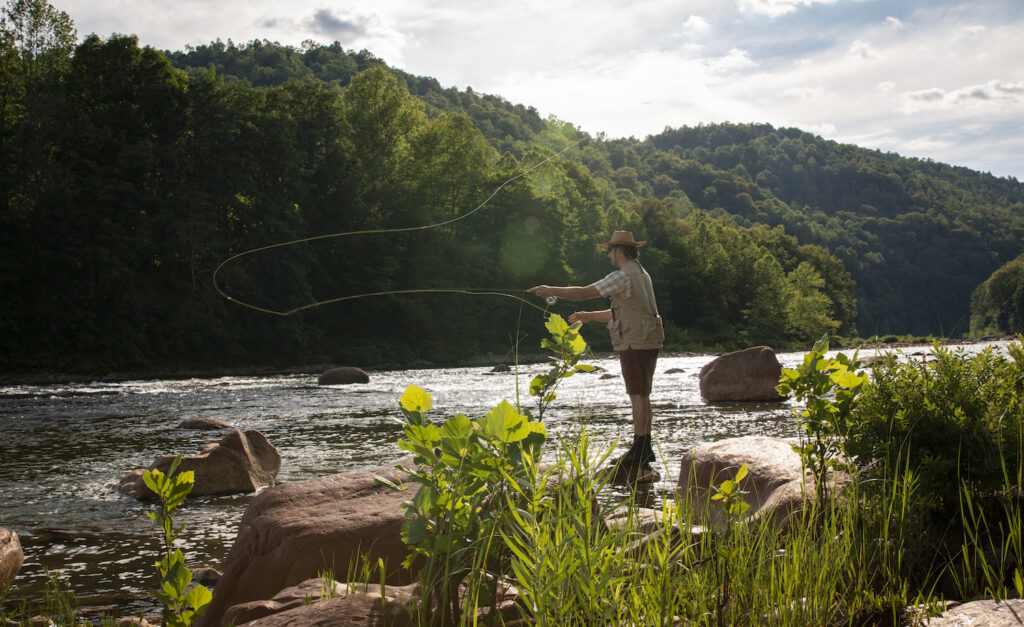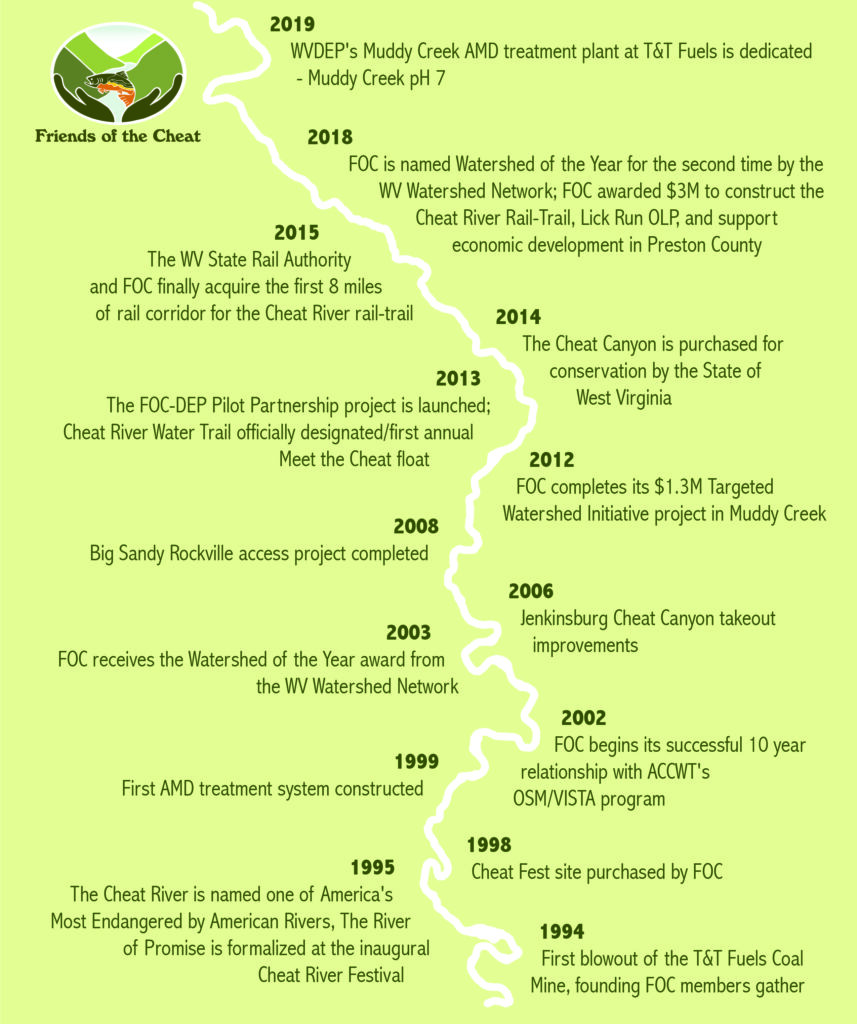In the spring of 1994, polluted water from an illegally-sealed major underground coal mine blew out the hillside and poured into Muddy Creek. This massive release of mine water entered the main stem of the Cheat River just upstream of the Cheat Canyon.
And turned the river orange for miles. The resulting discharge impacted not only the Cheat Canyon, but also lowered the pH in Cheat Lake to 4.5. A second blowout in 1995 further accentuated the problem and caused American Rivers, Inc., a national river conservation organization, to name the Cheat as one of the nation’s ten most endangered rivers.
The two founding principles of the organization:
1) To restore, preserve, and promote the outstanding natural qualities of the Cheat River watershed
2) To foster a cooperative effort by state and federal agencies, private industry, academics, grassroots organizations, and local landowners to address the severe AMD issues in the Cheat River watershed.
In 1995, acting on these principles, FOC facilitated the formation of the River of Promise Task Force (ROP), a group of diverse stakeholders committed to restoring the Cheat River watershed. ROP includes local, state, and federal agencies as well as academia, industry, local businesses, and other non-governmental organizations.
Water quality in the Cheat declined steadily throughout the 1900s
Beginning in the 1970s, whitewater paddlers on the Cheat River observed water quality becoming increasingly degraded by acid mine drainage (AMD) discharging from abandoned mine lands and active coal mine operations. Rocks in the river were stained with a bright orange color that became more apparent in the Cheat River Canyon each year. People who came from nearby states to raft and kayak complained of stinging eyes, nosebleeds, and other ailments after having spent time in the Cheat’s waters. Following the 1994-95 mine blowouts, the Cheat’s whitewater industry suffered over a 50% drop in business, while whitewater participation increased nationally by 33% during the same time period.
Water quality had been bad for many years, but the mine blowouts forced the issue into the consciousness of a greater public audience. In response to the mine blowouts, concerned citizens and stakeholders organized Friends of the Cheat (FOC) to begin to address the problems resulting from over a century of coal mining.
River of Promise Purpose and Goals
- To restore, care for, and promote the outstanding resources and qualities of the Cheat River Watershed for the people of West Virginia and the region.
- Expand efforts to identify significant sources of acid mine drainage (AMD) pollution in the Cheat River Watershed.
- Increase public awareness of the extent and impacts of AMD in the watershed.
- Work together to target streams that contribute significant AMD and select or develop effective technologies to mitigate that pollution.
- Work in concert to secure funding for AMD mitigation projects.
- Implement financially and technically effective AMD mitigation projects.
- Monitor the status of water quality and fisheries in the watershed and share data.
- Promote recreational use of the river and its contribution to local economies.
Advantages of the River of Promise approach
- Promotes communication and awareness between interest groups and agencies of problems and potential solutions.
- Fosters new partnerships between agencies, leveraging new funding sources to the watershed.
- Increases effectiveness by sharing resources and expertise.
- Provides “critical mass” to gaining support for large projects or initiatives.
- Crosses political boundaries in watershed issues.
- Maintains stakeholder input in prioritization and management issues in watershed.
Into the future
Meeting quarterly and chaired by Friends of the Cheat, ROP coordinates and initiates remediation projects throughout the watershed.
Millions of dollars in projects have been implemented since the inception of the River of Promise, including water monitoring programs, water quality assessments, and reclamation projects.
The partners in the River of Promise truly do “share a commitment”. This approach has accomplished much and will continue to restore the natural qualities of the Cheat Watershed for the benefit of all users and inhabitants.
Partners
Allegheny Energy
Anker Energy
Canaan Valley Institute
Cheat Lake Environment and Recreation Association
Downstream Alliance
Friends of the Cheat
National Biological Survey
National Mine Lands Reclamation Center
Preston County Commission
Trout Unlimited, WV State Council
West Virginia Division of Environmental Protection
West Virginia Division of Natural Resources
West Virginia Rivers Coalition
West Virginia University: College of Agriculture and Forestry
United States Department of Agriculture
Natural Resources Conservation Service
United States Department of Energy
Federal Energy Technology Center
United States Department of the Interior
Fish and Wildlife Service
National Park Service Rivers, Trails, and Conservation Assistance
Office of Surface Mining
United States Geological Survey
United States Environmental Protection Agency Region III
Cheat River Festival
To celebrate and raise awareness for the continued restoration of the Cheat River, FOC members decided to have a festival. The first Cheat River Festival, held on May 6, 1995, was hosted by Friends of the Cheat, West Virginia Rivers Coalition, and American Whitewater Affiliation – promising that 100% of the proceeds would be used to help protection and restoration efforts within the Cheat watershed. The Cheat River Festival continues to be a great demonstration of public support for FOC, environmental stewardship, and access to the Cheat River’s outstanding natural and recreational qualities.



